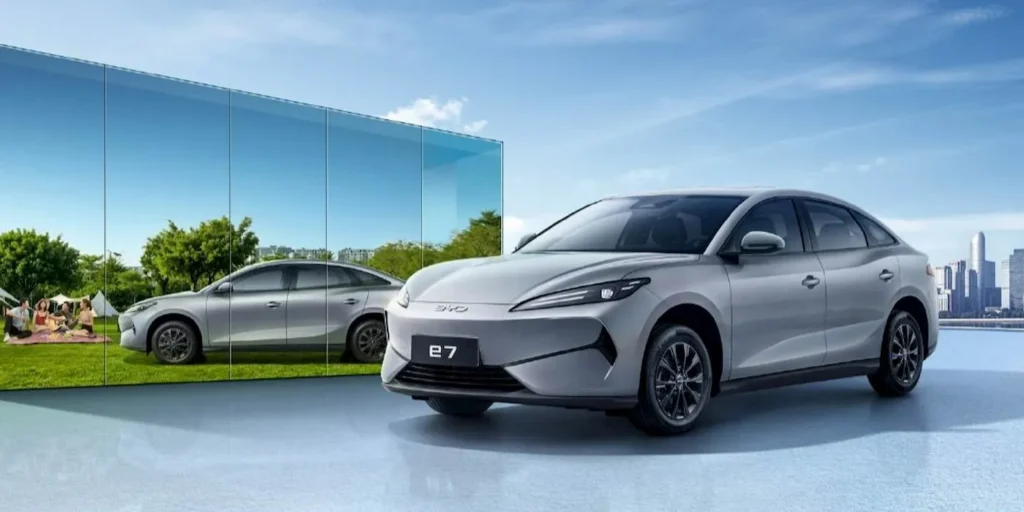I was scrolling through X last week, jaw dropped, as I saw the news: BYD, China’s EV juggernaut, slashed prices on 22 models, including a budget-busting 20% cut on their Seagull hatchback, now a steal at $7,750.

This isn’t just a sale—it’s a full-on price war, sparked by BYD and fanned by Tesla’s earlier cuts in 2023. It’s like watching carmakers duke it out in a Black Friday brawl, except the prize is your next ride.
China’s EV market, already at a wild 50% penetration (compared to the U.S.’s measly 10%), is now a buyer’s paradise.
But here’s the catch: with inventory piling up to 3.5 million vehicles and dealers sweating bullets, you’ve got to play this smart.
This price war is a golden ticket to score a high-tech EV on the cheap, but one wrong move, and you’re stuck with a depreciating lemon. Let’s dive into how you can cash in on this chaos without getting burned.
Overview of BYD’s EV Price War and Its Consumer Impact

BYD’s playing hardball. With a 5.5 million annual delivery target and control over everything from batteries to chips, they’re slashing prices like a chef chopping onions—fast and relentless.
The Seagull’s down 20%, the Seal hybrid sedan’s cut by 34% to 102,800 yuan ($14,250), and rivals like Geely and Leapmotor are scrambling to keep up.
Discounts hit 16.8% on average in April 2025, per the China PCA. For buyers, this means EVs are cheaper than ever, with tech like Huawei’s 1-km-per-second charging or BYD’s free driver-assist upgrades thrown in.
But there’s a dark side: most Chinese EV makers are bleeding cash, profit margins are a measly 5%, and smaller brands are teetering on bankruptcy.
Add in 50% depreciation in three years, and you need to tread carefully to make this price war work for you. Timing’s everything—dealers are desperate, but consolidation’s looming, and options might shrink fast.
Practical Tips to Save Big During the Price War

Research Models with the Deepest Discounts
First, zero in on the juiciest deals. BYD’s Seagull at $7,750 is a no-brainer for budget buyers—it’s cheaper than a used Civic and has more tech than my old laptop.
The Seal hybrid, down 34%, is another gem, blending EV efficiency with gas backup. But don’t stop at BYD. Leapmotor and Changan are matching cuts to clear their lots, so compare prices like you’re hunting for Black Friday deals.
Check for sneaky incentives—low-interest loans or trade-in bonuses are popping up as dealers panic over 57 days’ worth of unsold cars.
I once haggled $1,500 off a used EV by pointing out a rival’s deal; dealers hate losing a sale. Use online tools like the China PCA price tracker or global EV comparison sites to stay ahead of the curve. Knowledge is power, and in this market, it’s also cash.
Time Your Purchase Strategically
Timing’s your secret weapon. April and May 2025 saw discounts peak at 16.8%, and year-end sales could push them higher as dealers scramble to clear 3.5 million vehicles.
Last year, I walked into a dealership right before the holidays and snagged a hybrid with a $2,000 discount because the manager was sweating inventory quotas.
But don’t get greedy waiting for rock-bottom prices-buyers delaying for deeper cuts are clogging the market, and with consolidation looming (analysts predict a shakeout by 2027), hot models might vanish.
Dealerships are under pressure, so haggle hard, especially on older models without fancy driver-assist tech. I’d rather drive away in a discounted Seagull than wait for a deal that might never come.
Evaluate Total Cost of Ownership
Price tags are sexy, but ownership costs are the real story. EVs like the Seagull save you on fuel—think $1,000 a year versus a gas guzzler—but depreciation’s a buzzkill.
Chinese EVs lose 50% of their value in three years, compared to 30–40% for gas cars, per a 2024 study. I learned this the hard way when I sold my old Nissan Leaf for peanuts after three years.
Pick a brand like BYD with strong resale potential, and check battery warranties 2–3% annual capacity loss is normal, but a good warranty covers replacements.
Financing deals are tempting, but long-term loans can trap you if your EV’s value tanks. Crunch the numbers: fuel savings, maintenance (EVs need less), and insurance. It’s like planning a road trip-map it out, or you’ll end up lost.
Prioritize Safety and Quality Amid Cost-Cutting
Cheap doesn’t mean safe. With margins razor-thin, some brands might skimp on materials or testing. NREL says 99% of Li-ion batteries are safe, but thermal runaway (fancy term for battery fires) happens in under 1% of cases.
I once test-drove a budget EV that felt like it was held together with duct tape-steering was mushy, and the dashboard rattled like my grandma’s old Buick.
Stick to brands like BYD or Li Auto, which are profitable and less likely to cut corners. Confirm that discounted models still pack promised tech, like driver-assist or fast charging.
And research the manufacturer’s stability—smaller brands might fold, leaving you with a car that’s basically an orphan. Nobody wants a warranty that’s worth less than the paper it’s printed on.
Explore the Secondhand Market for Bargains
The price war’s a goldmine for used EVs. Rapid price cuts mean 2024 models are dirt cheap—think Seagull-level prices without the new-car markup.
I snagged a used EV last year for half its original price because the owner panicked over new models dropping. But batteries degrade 2–3% a year, so get a pro to check the range before buying.
Dealerships are slashing prices on older models without the latest tech, so negotiate like you’re at a flea market.
Just don’t expect to resell for much—EVs age like smartphones, not fine wine. Bargain hunters, this is your moment.
Navigating Challenges in the Price War
Avoid Common Pitfalls
Low prices can blind you. I once fell for a cheap EV deal, only to find the battery warranty was a joke and repairs cost a fortune.
Don’t just chase the lowest sticker price—research reliability and read owner reviews on EV forums.
Financing traps are real; low-interest loans sound great but can lock you into payments longer than your car’s value lasts.
And keep an eye on market shifts—smaller brands are dropping like flies, and you don’t want to be stuck with a car from a company that’s gone kaput. Stay sharp, or you’ll be crying over more than just a bad deal.
Balance Innovation with Practicality
The price war’s pushing cool tech-Huawei’s chargers add 1 km of range per second, and BYD’s handing out free driver-assist upgrades.
But don’t pay for features you’ll never use, like my buddy who got a fancy infotainment system he still can’t figure out.
If charging stations are scarce where you live, consider plug-in hybrids like the Seal they’re cheaper than full EVs and perfect for spotty infrastructure. It’s like choosing between a sports car and a pickup-pick what fits your life, not your ego.
Conclusion: Grab the Wheel and Save Smart

BYD’s price war is a once-in-a-decade shot to snag a high-tech EV without breaking the bank.
With discounts hitting 16.8% and models like the Seagull at $7,750, you’re closer than ever to ditching gas for good.
But don’t just dive in-research deals, time your buy, and prioritize quality to avoid a lemon. Use tools like the PCA price tracker to stay ahead, and maybe get a mechanic to check that used EV’s battery.
The market’s consolidating fast, so act before your options shrink. Sure, there’s risk-depreciation stings, and some brands might not survive but play it smart, and you’ll drive away with a deal that makes your wallet sing.
Now, go hunt that bargain before the price war leaves you in the dust.
